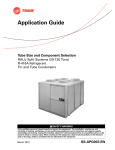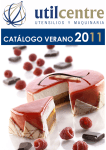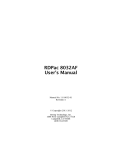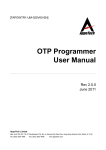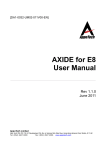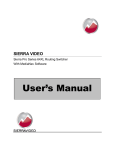Download Trane RAUJ CAUJ 20 to 120 Tons Catalogue
Transcript
Product Catalog Split System Condensing Units —RAUJ Remote Chiller Evaporators 20 - 120 Tons — 50/60 Hz — R-410A March 2012 SS-PRC030-EN Introduction Trane 20 to 120-ton air-cooled condensing units are the leaders in the split system marketplace. Designed for efficiency, reliability and flexibility, the Trane units have the most advanced design in the industry. All 20 to 120-ton units feature the Trane 3-D™ Scroll compressor, solid-state controls and Trane’s exclusive Packed Stock Plus availability 20 to 60 tons for quick shipment. These innovations make an already proven product even better! Trademarks Trane and the Trane logo are trademarks of Trane in the United States and other countries. All trademarks referenced in this document are the trademarks of their respective owners. © 2012 Trane All rights reserved SS-PRC030-EN Table of Contents Introduction . . . . . . . . . . . . . . . . . . . . . . . . . . . . . . . . . . . . . . . . . . . . . . . . . . . . . . . . . . . . 2 Features and Benefits . . . . . . . . . . . . . . . . . . . . . . . . . . . . . . . . . . . . . . . . . . . . . . . . . . . 4 Application Considerations . . . . . . . . . . . . . . . . . . . . . . . . . . . . . . . . . . . . . . . . . . . . . . 6 Selection Procedure . . . . . . . . . . . . . . . . . . . . . . . . . . . . . . . . . . . . . . . . . . . . . . . . . . . . 9 20 to 60-Ton Units . . . . . . . . . . . . . . . . . . . . . . . . . . . . . . . . . . . . . . . . . . . . . . . . 10 80 to 120-Ton Units2 . . . . . . . . . . . . . . . . . . . . . . . . . . . . . . . . . . . . . . . . . . . . . . . . . . . . . . . . . . . 10 Model Number Descriptions . . . . . . . . . . . . . . . . . . . . . . . . . . . . . . . . . . . . . . . . . . . . 10 General Data . . . . . . . . . . . . . . . . . . . . . . . . . . . . . . . . . . . . . . . . . . . . . . . . . . . . . . . . . . 11 Performance Data . . . . . . . . . . . . . . . . . . . . . . . . . . . . . . . . . . . . . . . . . . . . . . . . . . . . . 13 60 Hz Data . . . . . . . . . . . . . . . . . . . . . . . . . . . . . . . . . . . . . . . . . . . . . . . . . . . . . . . 13 50 Hz Data . . . . . . . . . . . . . . . . . . . . . . . . . . . . . . . . . . . . . . . . . . . . . . . . . . . . . . . 17 Controls . . . . . . . . . . . . . . . . . . . . . . . . . . . . . . . . . . . . . . . . . . . . . . . . . . . . . . . . . . . . . . 25 Standard Options 20 to 120-Ton Condensing Units . . . . . . . . . . . . . . . . . . . . 25 Electrical Data . . . . . . . . . . . . . . . . . . . . . . . . . . . . . . . . . . . . . . . . . . . . . . . . . . . . . . . . . 26 Dimensional Data . . . . . . . . . . . . . . . . . . . . . . . . . . . . . . . . . . . . . . . . . . . . . . . . . . . . . . 29 Weights . . . . . . . . . . . . . . . . . . . . . . . . . . . . . . . . . . . . . . . . . . . . . . . . . . . . . . . . . . . . . . 48 Mechanical Specifications . . . . . . . . . . . . . . . . . . . . . . . . . . . . . . . . . . . . . . . . . . . . . . 50 20 to 120-ton Condensing Units . . . . . . . . . . . . . . . . . . . . . . . . . . . . . . . . . . . . . 50 Remote Evaporator Chillers . . . . . . . . . . . . . . . . . . . . . . . . . . . . . . . . . . . . . . . . 51 SS-PRC030-EN 3 Features and Benefits Trane 3-D Scroll Compressor Simple Design with 70% Fewer Parts Fewer parts than an equal capacity reciprocating compressor means significant reliability and efficiency benefits. The single orbiting scroll eliminates the need for pistons, connecting rods, wrist pins and valves. Fewer parts lead to increased reliability. Fewer moving parts, less rotating mass and less internal friction means greater efficiency than reciprocating compressors. The Trane 3-D Scroll provides important reliability and efficiency benefits. The 3-D Scroll allows the orbiting scrolls to touch in all three dimensions, forming a completely enclosed compression chamber which leads to increased efficiency. In addition, the orbiting scrolls only touch with enough force to create a seal; there is no wear between the scroll plates. The fixed and orbiting scrolls are made of high strength cast iron which results in less thermal distortion, less leakage, and higher efficiencies. The most outstanding feature of the 3-D Scroll compressor is the greater tolerance to slugging tha reciprocating compressors. Low Torque Variation The 3-D Scroll compressor has a very smooth compression cycle; torque variations are only 30 percent of that produced by a reciprocating compressor. This means that the scroll compressor imposes very little stress on the motor resulting in greater reliability. Low torque variation reduces noise and vibration Suction Gas Cooled Motor Compressor motor efficiency and reliability is further optimized with the latest scroll design. Cool suction gas keeps the motor cooler for longer life and better efficiency. Proven Design Through Testing and Research With over twenty years of development and testing, Trane 3-D Scroll compressors have undergone more than 400,000 hours of laboratory testing and field operation. This work combined with over 25 patents makes Trane the worldwide leader in air conditioning scroll compressor technology. Voltage Power Supply 20 to 120-ton units have four voltage options in 200, 230, 460 and 575. Passive Manifolding Trane offers a parallel manifolding scheme that uses no moving mechanical parts. This feature assures continuous oil return, again providing greater system reliability. And greater reliability means optimal performance over the life of the unit. Additional Features System Control Options In addition to “no system control” option, Trane offers three system control options on 20-60 ton units and two system control options on the 80-120 ton units, each using solid- state electronics. These options allow the unit to be ordered with the controls needed, saving field installation costs. 4 SS-PRC030-EN Features and Benefits Coil Frost Protection Trane offers Frostat™ with the VAV system control option on the 20 to 120-ton units. FROSTAT is the industry’s most reliable method of coil frost protection and assures that your system will provide energy efficient comfort at part load conditions. Remote Chiller Evaporator Option with Field Installation Kit Allows chilled water to be generated remotely from the condensing section. The EVP option is controls only and includes unit controller, discharge water temperature sensor and water freezestat. Accessory kit includes evaporator, with mounting hardware and insulation, water strainer, minimum water flow limit switch and evaporator pipe stubs with couplings. Control option must be selected with accessory kit. 20 to 120-Ton Units Standard Features • • • • • • • • Trane 3-D™ Scroll compressors Phase Loss/Reversal/Low Voltage Monitor Factory-installed Discharge and Liquid Line Service Valves Passive manifolding for 3-D Scroll compressors Standard ambient operating range 40°F to 125°F (115°F max ambient for EVP chiller) Heavy gauge galvanized steel frame Louvered panels for coil protection Slate gray air-dry paint finish Optional Features • • • • • • • • • • • • • • Remote chiller evaporator with field installation kit Non-fused disconnect (20 to 60-Ton Models) Low ambient option Hot gas bypass to the evaporator inlet Suction service valve Pressure gauges Return air sensor Unit spring isolators Neoprene-in-shear isolators cULus approval (not available for 50 Hz) Packed Stock Plus program (20 to 60-Ton Models) Extended Compressor Warranty Corrosion protected condenser coil Constant volume, VAV, and no controls options on 20 to 60-Ton models, VAV and no controls options on 80 to 120-Ton Models Packed Stock Plus Trane 20 to 60-ton air-cooled condensing units are available through the most flexible packed stock program in the industry. Trane knows that you want your units on the job site, on time, with the options you need. Packed Stock Plus provides you with the controls and options you need — options like hot gas bypass, isolators and refrigerant gauges. You no longer have to settle for a basic unit requiring many field installed options to meet your job schedule. Now, you can get a customized unit from the factory in record time. The Packed Stock Plus program provides more control over unit selection and scheduling than ever before. Trane wants to make it easy for you to do business with them. SS-PRC030-EN 5 Application Considerations Certain application constraints should be considered when sizing, selecting and installing Trane aircooled condensing units. Unit reliability is dependent upon these considerations. Where your application varies from the guidelines presented, it should be reviewed with the local Trane sales engineer. Unit Sizing Unit capacities are listed in the performance data section. Intentionally oversizing a unit to assure adequate capacity is not recommended. Erratic system operation and excessive compressor cycling are often a direct result of an oversized condensing unit. In addition, an oversized unit is usually more expensive to purchase, install and operate. If oversizing is desired, consider using two units. Unit Placement A base or foundation is not required if the selected unit location is level and strong enough to support the unit’s operating weight. Isolation and Sound Emission The most effective form of isolation is to locate the unit away from any sound sensitive area. Structurally transmitted sound can be reduced by using spring or rubber isolators. The isolators are effective in reducing the low frequency sound generated by compressors and, therefore, are recommended for sound sensitive installations. An acoustical engineer should always be consulted on critical applications. For maximum isolation effect, the refrigeration lines and electrical conduit should also be isolated. Use flexible electrical conduit. State and local codes on sound emissions should always be considered. Since the environment in which a sound source is located affects sound pressure, unit placement must be carefully evaluated. Servicing Adequate clearance for compressor servicing should be provided. Recommended minimum space envelopes for servicing are located in the dimensional data section of this catalog and can serve as guidelines for providing adequate clearance. The minimum space envelopes also allow for control panel door swing and routine maintenance requirements. Local code requirements may take precedence. Unit Location Unobstructed flow of condenser air is essential for maintaining condensing unit capacity and operating efficiency. When determining unit placement, careful consideration must be given to assure proper air flow across the condenser heat transfer surface. Failure to heed these considerations will result in warm air recirculation and coil air flow starvation. Warm air recirculation occurs when discharge air from the condenser fans is recycled back at the condenser coil inlet. Coil starvation occurs when free air flow to the condenser is restricted. Both warm air recirculation and coil starvation cause reductions in unit efficiency and capacity. In addition, in more severe cases, nuisance unit shutdowns will result from excessive head pressures. Accurate estimates of the degree of efficiency and capacity reduction are not possible due to the unpredictable effect of varying winds. When hot gas bypass is used, reduced head pressure increases the minimum ambient condition for proper operation. In addition, wind tends to further reduce head pressure. Therefore, it is advisable to protect the air-cooled condensing unit from continuous direct winds exceeding 10 miles per hour. Debris, trash, supplies, etc., should not be allowed to accumulate in the vicinity of the air-cooled condensing unit. Supply air movement may draw debris between coil fins and cause coil starvation. Special consideration should be given to units operating in low ambient temperatures. 6 SS-PRC030-EN Application Considerations Condenser coils and fan discharge must be kept free of snow and other obstructions to permit adequate air flow for satisfactory unit operation. Effect of Altitude on Capacity Condensing unit capacities given in the performance data tables are at sea level. At elevations substantially above sea level, the decreased air density will decrease condenser capacity and, therefore, unit capacity and efficiency. The adjustment factors in Table 4, p. 12 can be applied directly to the catalog performance data to determine the unit’s adjusted performance. Ambient Considerations Start-up and operation at lower ambients requires sufficient head pressure be maintained for proper expansion valve operation. At higher ambients, excessive head pressure may result. Standard operating conditions are 40°F to 125°F (115°F max ambient for EVP chiller). With a low ambient damper, operation down to 0°F is possible. Minimum ambient temperatures are based on still conditions (winds not exceeding five mph). Greater wind velocities will result in increased minimum operating ambients. Units with hot gas bypass have a minimum operating ambient temperature of 10°F. For proper operation outside these recommendations, contact the local Trane sales office. Coil Frost Protection Frostat™ is standard on condensing units when the VAV option is ordered. Frostat™ consists of a ship-with thermostat for field installation on the suction line. A timer is also factory-installed to avoid short cycling. Frostat™ cycles the compressor off when the suction line is below 30°F. Refer to S/S-EB-43 for more detail. When hot gas valves must be used on 20 to 120-ton units, they can be ordered as a miscellaneous option. The 20 to 30-ton units require one valve; 40 to 60-ton units also require one valve except when no system control option is selected; this option requires two valves. The 80 to 120-ton units require one valve when Supply Air VAV control is selected. Two valves are required on all other 80 to 120-ton control options. Refrigerant Piping Special consideration must always be given to oil return. Minimum suction gas velocities must always be maintained for proper oil return. Utilize Tube Size and Component Selectionapplication guide SS-APG012-EN for proper system design. For special applications, call Clarksville Product Support. Note: Under certain conditions, R-410A refrigerant can present special challenges with piping and system design. Whenever refrigerant line set lengths approach 150 equivalent feet and/or design ambient temperature exceeds 115°F, contact your Trane Account Executive to review application requirements. Remote Chiller Evaporator Water Treatment Using untreated or improperly treated water may result in scaling, erosion, corrosion, and algae or slime buildup in the heat exchanger that will adversely affect system capacity. Proper water treatment must be determined locally and depends on the type of system and local water characteristics. Neither salt nor brackish water is recommended, either will lead to a shortened heat exchanger life. Trane encourages employment of a qualified water treatment specialist, familiar with local water conditions, to assist in the establishment of a proper water treatment program. Water Flow Limits The minimum and maximum water flow rates are given in Table 2, p. 12. Water flow rates below the tabulated values will result in laminar flow causing freeze-up problems, scaling, stratification and poor system control. Flow rates exceeding the maximum listed may result in very high pressure drop, erosion of the heat exchanger and damage to the water flow switch. SS-PRC030-EN 7 Application Considerations Water Temperature Limits RAUJ with remote EVP chiller performance data is based on a water temperature drop of 10°F. Full load chilled water temperature drops from 8 to 14°F may be used as long as minimum and maximum water temperature and minimum and maximum flow rates are not violated. Leaving water temperatures below 42°F require freeze protection down to 15°F. The maximum water temperature that can be circulated through the chiller when the unit is not operating is 125°F. Evaporator damage may result above this temperature. Short Water Loops Adequate chilled water system water volume is an important system design parameter because it provides for stable chilled water temperature control and helps limit unacceptable short cycling of chiller compressors. Typically, a five-minute water loop circulation time is sufficient to prevent short water loop issues. Therefore, as a guideline, ensure the volume of water in the chilled water loop equals or exceeds five times the evaporator flow rate. For systems with a rapidly changing load profile the amount of volume should be increased. Note: Water volumes should be calculated as close as possible to maintain constant water flow through the water loop. Water Piping Foreign matter in the chilled water system will increase pressure drop and reduce water flow. Installation of a properly selected strainer is also necessary to prevent debris larger than 0.039” from entering the heat exchanger. All building water piping must be thoroughly flushed before making the final piping connections to the heat exchanger. To reduce heat loss and prevent condensation, insulation should be applied to piping. Expansion tanks are also generally required to accommodate chilled water volume changes. 8 SS-PRC030-EN Selection Procedure Net capacity curves for the RAUJ condensing units are given in the performance data section. When matched with a coil curve, the resultant point of intersection will be the system design balance point. The design operating suction temperature and capacity can then be read directly from the graph. Note: It is usually necessary to account for suction and liquid line losses in the performance . The actual losses are determined by the interconnecting piping. To plot the DX evaporator performance curve it is only necessary to obtain gross evaporator capacities for the given entering air conditions and cfm at two different saturated suction temperatures. The Trane Refrigeration Coil Computer Selection Program can be used to conveniently provide the necessary evaporator capacity values at the selected suction temperatures. Selection Example The RAUJ 20 to 120-Ton TOPSS™ selection program provides the ability to generate performance output for pre-selected Trane Modular Climate Changer evaporator coils with the RAUJ condensing units. To select a condensing unit and evaporator coil not available in the RAUJ TOPSS™ program, the example below can be used to cross-plot an evaporator coil with known performance with the RAUJ condensing unit From the Trane Refrigeration Coil Computer Selection Program: DX Evap Coil = Model Number DFDB42 - 42" X 60" / 4 Row / 144 FPF - FD/Delta-flo E Entering Coil Conditions = 80/67 DB/WB and 95°F Ambient - 8500 CFM Coil Performance @ 38F SST - 406.49 MBh Total Coil Performance @ 45F SST - 293.09 MBh Total Balance Point at 95°F Ambient = 370 MBh @ 40.2 SST Coils are identical fin series and circuiting on both simulations. Figure 1. 30 Ton condensing unit performance - RAUJ-C30 (60 Hz) 475 Evaporator coil line 406.49MBH @ 38F SST Net Capacity(MBH) 425 375 325 293.09MBH @ 45F SST 275 225 30 32 34 36 38 40 42 44 46 48 50 Saturated Suction(F) By plotting the two coil performance outputs across the RAUJC30 Net Capacity curve at their respective total MBH at the defined saturated suction temperatures and ignoring line losses,, we can see that the condenser/evaporator coil combination, at 95 F ambient, provides 370 MBH Net Capacity at 40.2 SST. SS-PRC030-EN 9 Model Number Descriptions 20 to 60-Ton Units1 Digit 17 Digit 13 — Number of Circuits G = Return Air Sensor 2 = Dual (All 80-120 Ton) Digit 1 — Unit Type Digit 18 Digit 14 R = Condensing Unit J = Corrosion Protected Condenser Coil B = Hot Gas Bypass Valve Digit 2 — Condenser Digit 19 Digit 15 A = Air Cooled C = Remote Chiller Evaporator & Install Kit T = Flow Switch (EVP Control Only) D = Suction Service Valves Digit 3 — Airflow U = Upflow Digit 4 — Development Sequence Digit 20 1 = Spring Isolators 2 = Neoprene Isolators J= Third Digits 5,6,7 — Nominal Capacity C20 = 20 Tons C25 = 25 Tons C30 = 30 Tons C40 = 40 Tons C50 = 50 Tons C60 = 60 Tons 80 to 120-Ton Units2 Digit 1 — Unit Type R = Remote Condensing Unit E = 200/60/3 XL D = 415/50/3 XL F = 230/60/3 XL 4 = 460/60/3 XL 5 = 575/60/3 XL 9 = 380/50/3 XL Digit 4 — Development Sequence B = No System Control E = Supply Air VAV Control P = EVP Control DIGIT 14 B = Hot Gas Bypass Valve Digit 10 — Design Sequence (Factory Assigned) A = First B = Second Etc. Digit 11 — Ambient Control DIGIT 15 0 = Standard 1 = 0°F (Low Ambient Dampers) D = Suction Service Valves Digit 12 — Agency Approval DIGIT 16 0 = None 3 = cULus (not available for 50 Hz) F = Pressure Gauges and Piping 1 The service digit for each model number contains 21 digits; all 21 digits must be referenced. 10 C = Remote Chiller Evap & Install Kit 3 = Flow Switch ( EVP Control only) Digit 8 — Voltage and Start Characteristics Digit 9 — System Control A = Non Fused Unit Disconnect Switch Digit 19 C80 = 80 Tons D10 = 100 Tons D12 = 120 Tons 0 = Standard 1 = 0°F (Low Ambient Dampers) DIGIT 13 1 = Spring Isolators Digits 5,6,7 — Nominal Capacity DIGIT 11 — Ambient Control 0 = None 3 = cULus (not available for 50 Hz) Digit 18 J = Third (Factory Assigned) A = First B = Second Etc. DIGIT 12 — Agency Approval J = Corrosion Protected Condenser Coil U = Upflow E = 200/60/3 XL F = 230/60/3 XL 4 = 460/60/3 XL 5 = 575/60/3 XL * = 380/50/3 XL2 * = 415/50/3 XL2 Digit 10 —Design Sequence Digit 17 A = Air-Cooled Digit 3 — Airflow B = No System Control C = Constant Volume Control E = Supply Air VAV Control P = EVP Control F = Pressure Gauges and Piping Digit 2 — Condenser Digit 8 — Voltage and Start Characteristics Digit 9 — System Control Digit 16 2 Contact the local Trane Sales Office for ordering information regarding 80-120 50Hz models. SS-PRC030-EN General Data Table 1. General data - 20-120 ton condensing units Model Number RAUJ-C20 RAUJ-C25 RAUJ-C30 RAUJ-C40 RAUJ-C50 RAUJ-C60 RAUJ-C80 RAUJ-D10 RAUJ-D12 Compressor Data Type Scroll Scroll Scroll Scroll Scroll Scroll Scroll Scroll Scroll 10T + 10T 10T +13.5T 15T + 15T 10T + 10T 11.5T + 13.5T 15T + 15T 15T + 15T + 15T + 15T + 20T + 20T + 15T 20T 20T 10T + 10T 11.5T + 13.5T 15T + 15T 15T + 15T + 15T + 15T + 20T + 20T + 15T 20T 20T Manifolded Sets Circuit 1 Circuit 2 Unit Capacity Steps (%) 100-42 100-50 100-75-5025 100-73-4623 100-75-5025 100-83-6650-33-17 100-80-6045-30-15 3/26"/Prop Direct 3/1.0 20700 3/26:/Prop Direct 3/1.0 20700 4/26"/Prop Direct 4/1.0 26790 6/26"/Prop Direct 6/1.0 36890 6/26"/Prop Direct 6/1.0 40490 8/26"/Prop Direct 8/1.0 56490 12/26"/Prop 12/26"/Prop Direct Direct 12/1.0 12/1.0 73890 76280 2/42x71 2/42x71 2/42x71 2/59x71 2/51x96 2/51x96 4/59x71 4/51x96 4/64x96 41.4 41.4 41.4 58.2 68.0 68.0 116.4 136.0 170.7 1/240 1/240 1/240 1/240 1/240 1/240 1/240 1/240 1/240 18.7 18.7 18.7 23.5 25.0 25.0 47.1 50.0 62.9 100-50 100-83-6650-33-17 Condenser Fan Data Qty/Fan Dia. Type 2/26"/Prop Fan Drive Type Direct No. of Motors/HP Ea. 2/1.0 Nominal Total CFM 14600 Condenser Coil Data Number of Coils/ Size (Inches) Face Area (Sq. Ft.) Rows/Fin Per Ft. Condenser Storage Capacity (Lbs)(a) Type Refrigerant Microchannel Data(b) No. Refrigerant Circuits Refrigerant Type Refrigerant Operating Charge (Lbs.)/Unit(c) (d) 1 1 1 2 2 2 2 2 2 R-410A R-410A R-410A R-410A R-410A R-410A R-410A R-410A R-410A 11.9 11.8 11.8 22.7 23.4 23.8 57.1 59.1 65.3 Outdoor Air Temperature for Mechanical Cooling Standard Ambient Operating Range (F)(e) 40-125 40-125 40-125 40-125 40-125 40-125 40-125 40-125 40-120 Low Ambient Option (F) 0 0 0 0 0 0 0 0 0 88.25 60.12 68 88.25 61.12 68 88.25 60.12 68 88.25 88.25 73 113.82 88.25 73 113.82 88.25 73 176.25 in, 88.25 73 227.25 in 88.25 73 227.25 in 88.25 73 Cabinet Dimensions Length (Inches) Width (Inches) Height (Inches) (a) Condenser storage capacity is given at conditions of 95°F outdoor temperature, and 95% full. (b) Refer to Refrigerant Piping in the Application Considerations section. (c) Operating charge is approximate for condensing unit only, and does not include charge for low side or interconnecting lines. (d) Condensing units are shipped with a nitrogen holding charge only. (e) Maximum operating ambient for EVP remote chillers is 115°F. SS-PRC030-EN 11 General Data Table 2. General data - 20 - 120 ton remote chillers RAUJC20 Model Number RAUJC25 RAUJC30 RAUJC40 RAUJC50 RAUJC60 RAUJC80 RAUJD10 RAUJD12 Shipping weight, lbs 44 84 113 90 135 157 208 292 320 Operating weight, lbs 56 104 142 131 206 244 330 473 520 No. of refrigerant circuits 1 1 1 2 2 2 2 2 2 Water volume, Gal 1.4 2.2 3.3 4.6 7.9 9.7 13.6 20.1 22.2 Chiller refrig charge @ AHRI condition, lbs 0.9 1.5 2.2 3.1 5.3 6.4 9.0 13.3 14.7 Minimum water flow rate, GPM 24 30 36 48 60 72 96 120 144 Maximum water flow rate, GPM 69 89 100 136 176 201 275 346 407 Chiller Water Supply/Return Pipe Size, in 2.0 2.0 2.0 3.0 3.0 3.0 4.0 4.0 4.0 Notes: 1. All heat exchangers are brazed plate. 2. All heat exchangers are single circuit on the water side. 3. Shipping and operating weights are approximate. 4. Refrigerant charge is approximate and for chiller only. 5. Applications with leaving water temperature below 42°F require freeze protection down to 15°F. 6. Maximum chiller operating ambient is 115°F. Table 3. EER data - condensing unit only(a) Net Cap (MBH) Total Compressor Condenser Fan kW kW Each/Total Control kW Total Power kW EER IEER RAUJ-C20 266.9 20.6 0.9/1.8 0.4 22.9 11.7 15.1 RAUJ-C25 324.9 23.9 0.9/2.7 0.4 26.9 12.1 15.1 RAUJ-C30 399.4 32.1 0.9/2.7 0.4 35.2 11.4 15.5 RAUJ-C40 545.5 42.4 0.9/3.6 0.7 46.7 11.7 15.4 RAUJ-C50 690.5 53.5 0.9/5.4 0.7 59.6 11.6 15.1 RAUJ-C60 786.6 64.4 0.9/5.4 0.7 70.5 11.2 15.3 RAUJ-C80 1121.0 94.3 0.9/7.2 0.7 102.1 11.0 15.4 RAUJ-D10 1374.0 109.3 0.9/10.8 0.7 120.7 11.4 15.6 RAUJ-D12 1661.0 134.3 0.9/10.8 0.7 145.6 11.3 15.7 Note: Capacity is rated in accordance with AHRI 365 - 95F Ambient, 45F Saturated Suction Temperature (a) Condensing unit only ratings are in accordance with AHRI standard 365. Full load ratings are at 95°F entering air temperature, and refrigerant conditions entering the condensing unit of 45°F saturated and 60°F actual temperature. Part load ratings are at 80°F entering air temperature and refrigerant conditions entering the condensing unit of 50°F saturated suction and 65°F actual temperature. Table 4. Altitude correction multiplier for capacity Altitude (ft.) 2,000 4,000 6,000 8,000 10,000 Condensing Unit Only 0.982 0.960 0.933 0.902 0.866 Condensing Unit / Air Handling Unit Combination 0.983 0.963 0.939 0.911 0.881 Condensing Unit With Evap. 0.986 0.968 0.947 0.921 0.891 12 SS-PRC030-EN Performance Data 60 Hz Data Figure 2. 20 Ton condensing unit performance — RAUJ-C20 (60 HZ) 325 300 Net Capacity MBH 275 250 225 200 175 150 30 32 34 36 38 40 42 44 46 48 50 46 48 50 Saturated Suction Temperature (F) Figure 3. 25 Ton condensing unit performance — RAUJ-C25 (60 HZ) 400 375 350 Net Capacity MBH 325 300 275 250 225 200 175 30 32 34 36 38 40 42 44 Saturated Suction Temperature (F) SS-PRC030-EN 13 Performance Data Figure 4. 30 Ton condensing unit performance — RAUJ-C30 (60 HZ) 475 450 425 Net Capacity MBH 400 375 350 325 300 275 250 225 30 32 34 36 38 40 42 44 46 48 50 46 48 50 Saturated Suction Temperature (F) Figure 5. 40 Ton condensing unit performance — RAUJ-C40 (60 HZ) 650 600 Net Capacity MBH 550 500 450 400 350 300 30 32 34 36 38 40 42 44 Saturated Suction Temperature (F) 14 SS-PRC030-EN Performance Data Figure 6. 50 Ton condensing unit performance — RAUJ-C50 (60 HZ) 850 800 750 Net Capacity MBH 700 650 600 550 500 450 400 30 32 34 36 38 40 42 44 46 48 50 46 48 50 Saturated Suction Temperature (F) Figure 7. 60 Ton condensing unit performance — RAUJ-C60 (60 HZ) 950 900 850 Net Capacity MBH 800 750 700 650 600 550 500 450 30 32 34 36 38 40 42 44 Saturated Suction Temperature (F) SS-PRC030-EN 15 Performance Data Figure 8. 80 Ton condensing unit performance — RAUJ-C80 (60 HZ) 1300 1250 1200 1150 1100 Net Capacity MBH 1050 1000 950 900 850 800 750 700 650 30 32 34 36 38 40 42 44 46 48 50 46 48 50 Saturated Suction Temperature (F) Figure 9. 100 Ton condensing unit performance — RAUJ-D10 (60 HZ) 1600 1500 Net Capacity MBH 1400 1300 1200 1100 1000 900 800 30 32 34 36 38 40 42 44 Saturated Suction Temperature (F) 16 SS-PRC030-EN Performance Data Figure 10. 120 Ton condensing unit performance — RAUJ-D12 (60 HZ) 2000 1900 1800 Net Capacity MBH 1700 1600 1500 1400 1300 1200 1100 1000 30 32 34 36 38 40 42 44 46 48 50 46 48 50 Saturated Suction Temperature (F) 50 Hz Data Figure 11. 20 Ton condensing unit performance — RAUJ-C20 (50 HZ) 275 250 Net Capacity MBH 225 200 175 150 125 30 32 34 36 38 40 42 44 Saturated Suction Temperature (F) SS-PRC030-EN 17 Performance Data Figure 12. 25 Ton condensing unit performance — RAUJ-C25 (50 HZ) 325 300 Net Capacity MBH 275 250 225 200 175 150 30 32 34 36 38 40 42 44 46 48 50 46 48 50 Saturated Suction Temperature (F) Figure 13. 30 Ton condensing unit performance — RAUJ-C30 (50 HZ) 400 375 350 Net Capacity MBH 325 300 275 250 225 200 175 30 32 34 36 38 40 42 44 Saturated Suction Temperature (F) 18 SS-PRC030-EN Performance Data Figure 14. 40 Ton condensing unit performance — RAUJ-C40 (50 HZ) 525 500 475 450 Net Capacity MBH 425 400 375 350 325 300 275 250 30 32 34 36 38 40 42 44 46 48 50 46 48 50 Saturated Suction Temperature (F) Figure 15. 50 Ton condensing unit performance — RAUJ-C50 (50 HZ) 675 625 Net Capacity MBH 575 525 475 425 375 325 30 32 34 36 38 40 42 44 Saturated Suction Temperature (F) SS-PRC030-EN 19 Performance Data Figure 16. 60 Ton condensing unit performance — RAUJ-C60 (50 HZ) 775 725 675 Net Capacity MBH 625 575 525 475 425 375 30 32 34 36 38 40 42 44 46 48 50 46 48 50 Saturated Suction Temperature (F) Figure 17. 80 Ton condensing unit performance — RAUJ-C80 (50 HZ) 1075 1025 975 925 Net Capacity MBH 875 825 775 725 675 625 575 525 30 32 34 36 38 40 42 44 Saturated Suction Temperature (F) 20 SS-PRC030-EN Performance Data Figure 18. 100 Ton condensing unit performance — RAUJ-D10 (50 HZ) 1350 1250 1150 Net Capacity MBH 1050 950 850 750 650 30 32 34 36 38 40 42 44 46 48 50 46 48 50 Saturated Suction Temperature (F) Figure 19. 120 Ton condensing unit performance — RAUJ-D12 (50 HZ) 1650 1550 1450 Net Capacity MBH 1350 1250 1150 1050 950 850 750 30 32 34 36 38 40 42 44 Saturated Suction Temperature (F) SS-PRC030-EN 21 Performance Data Table 5. System performance data — 20-120 Ton RAUJ with remote EVP chiller Entering Condenser Air Temperature (F) 85 Model RAUJ C20 RAUJ C25 RAUJ C30 RAUJ C40 RAUJ C50 RAUJ C60 RAUJ C80 22 95 105 115 LWFT(F) Capacity Tons Compr kW Capacity Tons Compr kW Capacity Tons Compr kW Capacity Tons Compr kW 40 18.8 17.5 17.7 19.4 16.6 21.4 15.4 23.7 42 19.4 17.8 18.3 19.6 17.2 21.7 16.0 23.9 44 20.1 18.0 19.0 19.8 17.8 21.9 16.6 24.1 46 20.8 18.2 19.6 20.0 18.4 22.1 17.1 24.3 48 21.5 18.4 20.2 20.3 19.0 22.3 17.7 24.5 50 22.1 18.6 20.9 20.5 19.6 22.5 18.3 24.7 40 23.3 20.5 21.9 22.7 20.5 25.1 19.0 27.7 42 24.1 20.7 22.7 22.9 21.2 25.3 19.7 28.0 44 24.9 21.0 23.5 23.1 22.0 25.5 20.4 28.2 46 25.8 21.2 24.3 23.4 22.7 25.8 21.1 28.4 48 26.6 21.5 25.1 23.6 23.5 26.0 21.8 28.7 50 27.5 21.7 25.9 23.9 24.2 26.3 22.5 28.9 40 28.4 27.2 26.8 29.8 25.0 32.7 23.3 35.8 42 29.4 27.6 27.7 30.2 25.9 33.1 24.1 36.1 44 30.4 27.9 28.6 30.5 26.8 33.4 25.0 36.5 46 31.4 28.3 29.6 30.9 27.7 33.8 25.8 36.8 48 32.4 28




















































